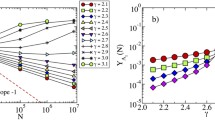Abstract
Bipartite systems show remarkable variations in their topological asymptotic properties, e.g., in their degree distribution. Such variations depend on the underlying growth dynamics. A scenario of particular importance is when the two partitions of the bipartite structure do not grow at an equal rate. Here, we focus on the case where one of the partitions can be assumed to be fixed while the other partition grows in time as observed in the codon-gene or alphabet-word network. We show that subtle changes in growth dynamics, particularly in the attachment kernel, can lead to drastic changes of the emergent topological properties. We present a detail analysis of various growth strategies, including sequential and parallel addition of nodes, as well as with and without replacement attachment kernels. Analytical results have been compared with stochastic simulations as well as with real systems showing in all cases an excellent agreement.
Similar content being viewed by others
References
M.E.J. Newman, Phys. Rev. E 64, 016131 (2001)
M.E.J. Newman, Phys. Rev. E 64, 016132 (2001)
A.L. Barabási, H. Jeong, R. Ravasz, Z. Néda, T. Vicsek, A. Schubert, Physica A 311, 590 (2002)
R. Lambiotte, M. Ausloos, Phys. Rev. E 72, 066117 (2005)
A.L. Barabási, H. Jeong, Z. Neda, E. Ravasz, A. Schubert, T. Vicsek, Physica A 311, 3 (2002)
S.H. Strogatz, Nature 410, 268 (2001)
G. Caldarelli, M. Catanzaro, Physica A 338, 98 (2004)
J.J. Ramasco, S.N. Dorogovtsev, R. Pastor-Satorras, Phys. Rev. E 70, 036106 (2004)
D.J. Watts, S.H. Strogatz, Nature 393, 440 (1998)
R. Albert, A.L. Barabási, Phys. Rev. Lett. 85, 5234 (2000)
M. Peltomäki, M. Alava, J. Stat. Mech. Theor. Exp. 1, P01010 (2006)
A.L. Barabási, R. Albert, Science 286, 509 (1999)
L.A.N. Amaral, A. Scala, M. Barthélémy, H.E. Stanley, Proc. Natl. Acad. Sci. 97, 11149 (2000)
L. Li, B.-Y. Gu, L. Chen, Complex Sciences, Lecture Notes of the Institute for Computer Sciences, Social Informatics and Telecommunications Engineering 4, 640 (2009)
M. Choudhury, N. Ganguly, A. Maiti, A. Mukherjee, L. Brusch, A. Deutsch, F. Peruani, Phys. Rev. E 81, 036103 (2010)
F. Peruani, M. Choudhury, A. Mukherjee, N. Ganguly, Europhys. Lett. 79, 28001 (2007)
A. Mukherjee, M. Choudhury, A. Basu, N. Ganguly, Journal of Quantitative Linguistics 16, 157 (2009)
Author information
Authors and Affiliations
Corresponding author
Rights and permissions
About this article
Cite this article
Ganguly, N., Saha, S., Maiti, A. et al. Effect of attachment strategies on bipartite networks. Eur. Phys. J. B 86, 287 (2013). https://doi.org/10.1140/epjb/e2013-30662-x
Received:
Revised:
Published:
DOI: https://doi.org/10.1140/epjb/e2013-30662-x




